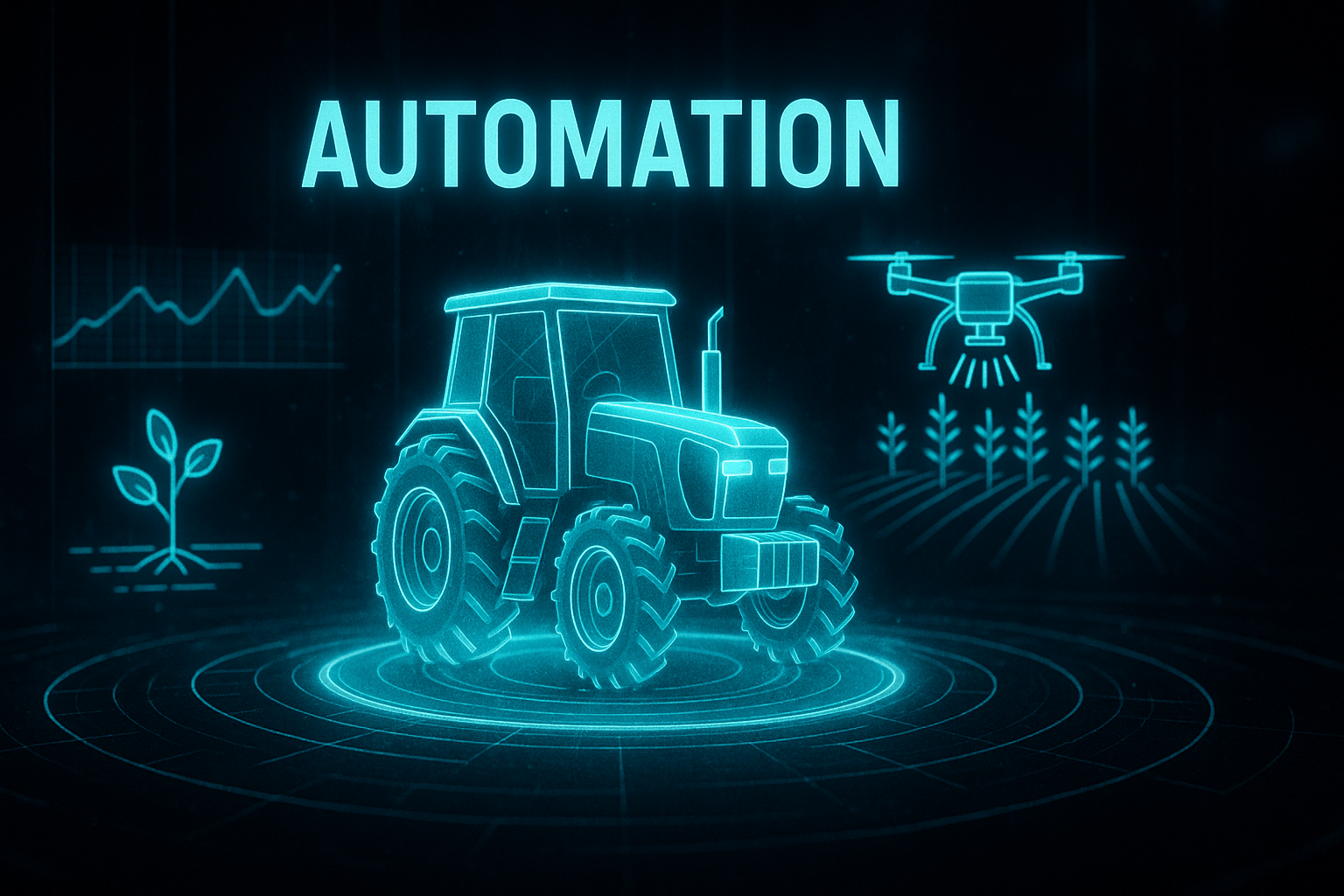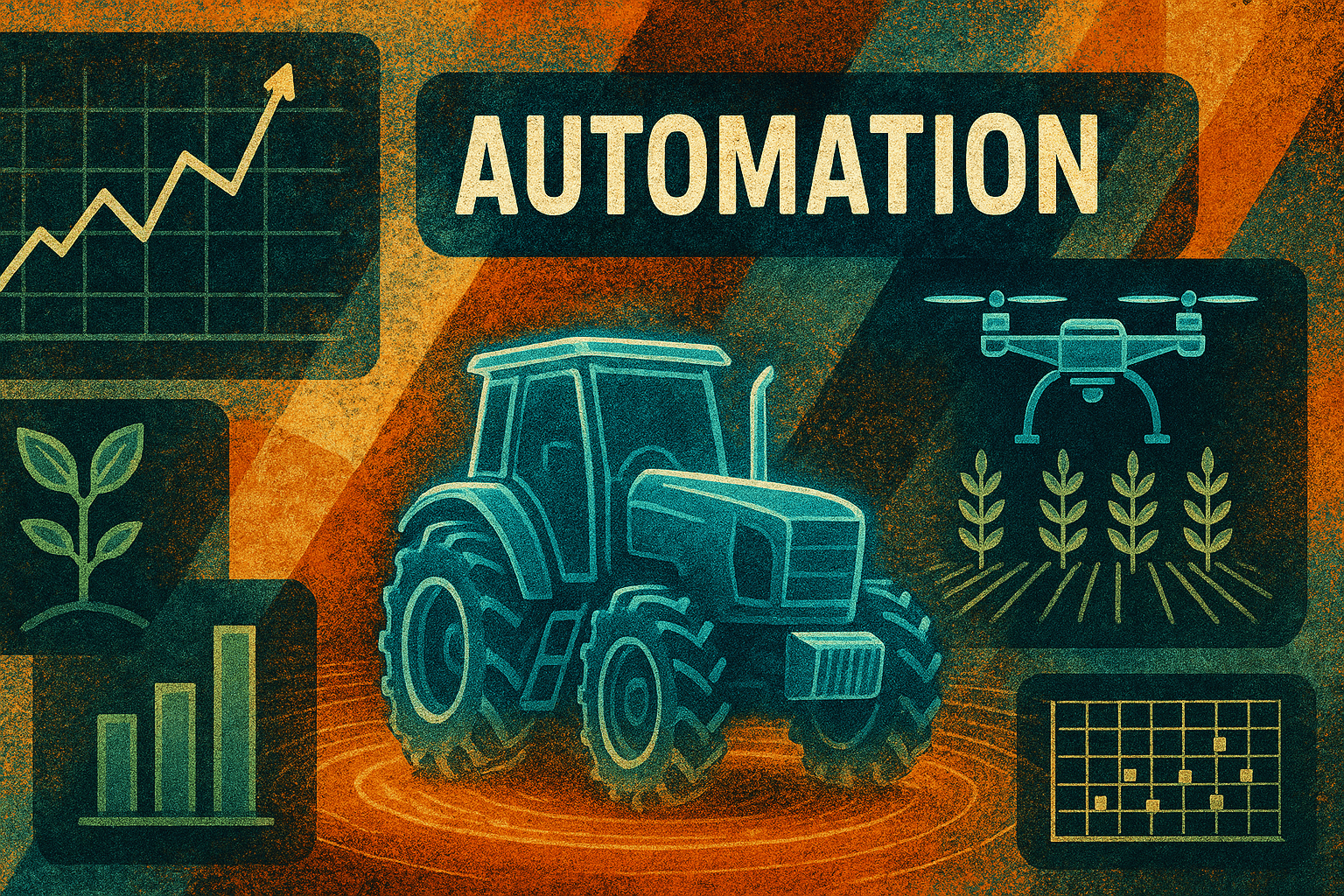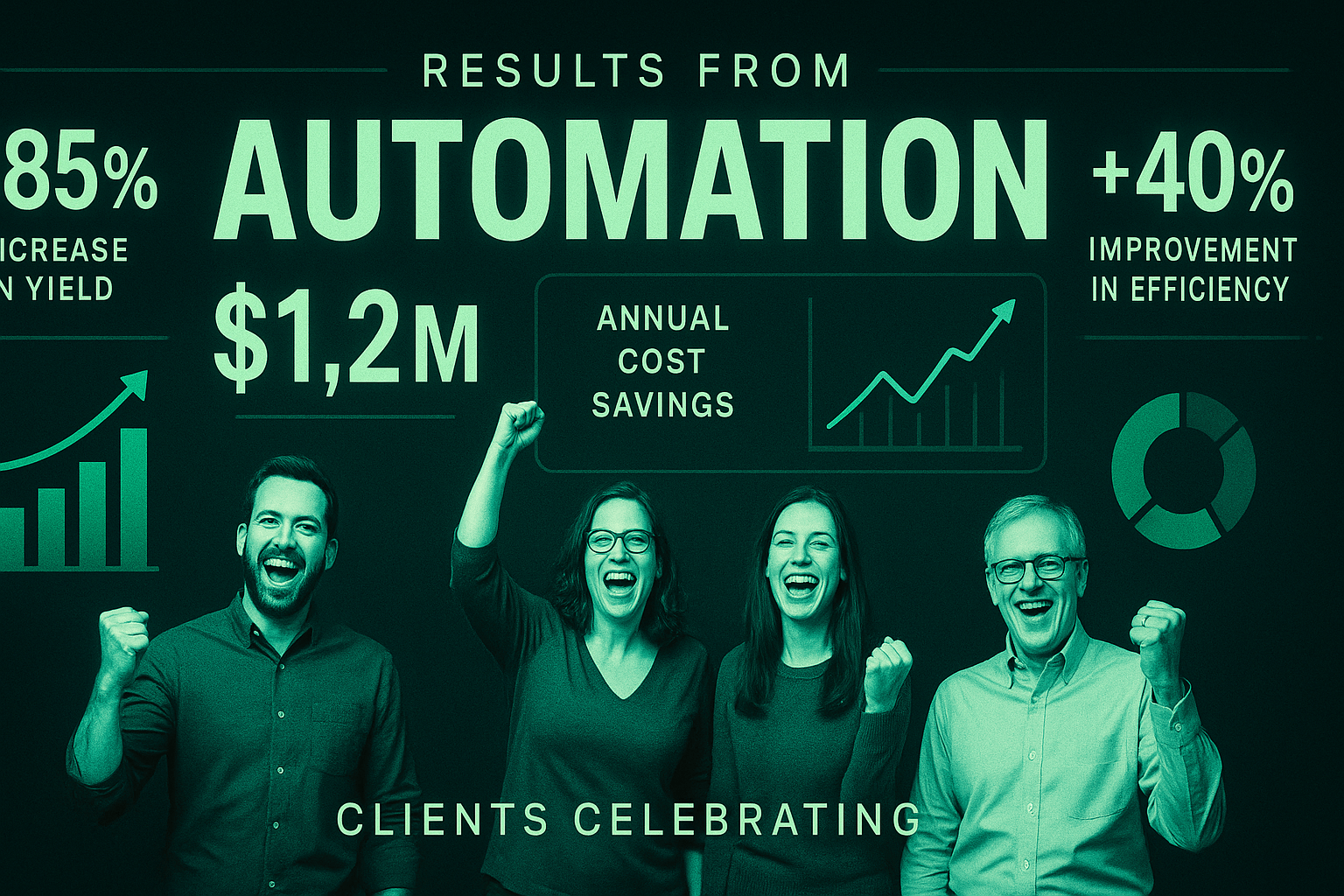Smart Automation for Agriculture & Farms: Boost Efficiency and Maximize Yields in 2026
by Design Delulu Editorial · October 19, 2025

Smart, fast, and measurable. Here's how Automation helps Agriculture & Farms win.
Modern agriculture faces unprecedented challenges: labor shortages, rising operational costs, climate unpredictability, and increasing demand for sustainable practices. The farms and agricultural operations that thrive in this environment aren't just working harder—they're working smarter through strategic automation. From precision irrigation systems to automated inventory management and data-driven decision-making, automation isn't just a competitive advantage anymore; it's becoming essential for survival and growth in today's agricultural landscape.
The transformation potential is remarkable. Forward-thinking farms are reducing manual labor costs by 30-40%, cutting water usage by up to 25%, and increasing crop yields by 15-20% through intelligent automation systems. But here's what separates successful implementations from costly failures: the right strategy, proper measurement infrastructure, and a clear roadmap that aligns technology with actual farm operations. This guide reveals how to build an automation framework that delivers measurable ROI while preserving the agricultural expertise that makes your operation unique.

Why Agriculture Operations Need Automation Now
The agricultural sector is experiencing a perfect storm of pressures that make automation not just beneficial, but necessary. Labor availability has declined by nearly 20% in rural areas over the past decade, forcing farms to do more with fewer hands. Meanwhile, consumer demand for transparency, sustainability certifications, and traceability requires documentation and data management that manual systems simply cannot handle at scale.
Climate variability adds another layer of complexity. Traditional farming intuition, while valuable, needs augmentation with real-time data and automated responses. A single irrigation miscalculation can waste thousands of gallons of water or damage an entire crop section. Automated systems that monitor soil moisture, weather patterns, and plant health can make split-second adjustments that human operators simply cannot match in speed or consistency.
Financial pressures are equally compelling. Input costs for seeds, fertilizers, and fuel have risen dramatically, while crop prices remain volatile. Automation helps farms optimize resource usage, reduce waste, and make data-driven decisions about timing, quantity, and placement of expensive inputs. The farms investing in automation today are building competitive moats that will be difficult for others to cross in the years ahead.
The Measurement Gap in Farm Automation
Most agricultural operations track basic metrics—acres planted, yields per acre, input costs—but lack the granular, real-time data needed to optimize operations continuously. Without proper tracking infrastructure, you're flying blind. You might know your overall yield increased, but can you attribute it to specific interventions? Can you identify which field sections consistently underperform? Can you calculate the true ROI of new equipment or techniques?
This is where proper automation infrastructure becomes transformative. By implementing comprehensive tracking systems—from IoT sensors to automated data collection and dashboards—you create a single source of truth that reveals patterns, validates decisions, and highlights opportunities invisible to manual observation alone.
Core Components of Agricultural Automation Systems
Effective farm automation isn't about implementing every available technology—it's about building an integrated system that addresses your specific bottlenecks and goals. Here are the foundational elements that make automation work in agricultural contexts:
1. Data Collection and IoT Infrastructure
The foundation of any automation system is reliable data collection. Modern agricultural operations deploy networks of sensors and connected devices that continuously monitor:
- Environmental conditions: Soil moisture levels, temperature, humidity, rainfall, wind speed, and solar radiation
- Crop health indicators: Growth rates, leaf moisture, pest presence, and disease markers through imaging systems
- Equipment performance: Fuel consumption, maintenance needs, operational hours, and productivity metrics
- Resource utilization: Water flow rates, fertilizer application amounts, energy consumption, and storage conditions
The key is ensuring these data streams feed into a centralized system where they can be analyzed collectively. Isolated data points have limited value; the magic happens when you can correlate soil moisture with irrigation schedules, weather forecasts, and historical yield data to optimize decisions.
2. Process Automation and Control Systems
Once you're collecting data, the next layer involves automated responses and processes. These systems take action based on predefined rules and real-time conditions:
- Precision irrigation: Automated watering systems that adjust based on soil moisture, weather forecasts, and crop stage
- Climate control: Greenhouse and livestock facility systems that maintain optimal temperature and humidity
- Feeding systems: Automated livestock feeding that adjusts portions based on animal weight, age, and production goals
- Sorting and grading: Vision systems that automatically sort produce by size, quality, and ripeness
The most sophisticated operations implement closed-loop systems where automation not only executes tasks but learns from outcomes and continuously refines its parameters.
3. Analytics and Decision Support
Raw data becomes actionable intelligence through proper analytics infrastructure. This includes:
- Real-time dashboards: Visual displays of current conditions, alerts, and key performance indicators
- Predictive models: Systems that forecast yields, identify optimal planting windows, or predict equipment failures before they occur
- Attribution modeling: Tools that help you understand which interventions drive specific outcomes
- Benchmarking: Comparison of your performance against historical data, similar operations, or industry standards
The goal is transforming data overload into clear, actionable insights that drive better decisions at every level—from daily operational choices to long-term strategic planning.

Implementation Framework: From Strategy to Results
Successful automation implementation follows a structured approach that minimizes risk while maximizing learning and ROI. Here's the proven framework used by leading agricultural operations:
Phase 1: Discovery & Strategic Alignment
Before investing in any technology, you need absolute clarity on what you're trying to achieve and how you'll measure success. This phase involves:
Identifying constraints and opportunities: What are your biggest operational bottlenecks? Where do you lose money through inefficiency? Which processes consume disproportionate labor or resources? Map your current operation comprehensively, including workflows, pain points, and areas where human judgment is critical versus where consistency matters most.
Defining success metrics: Establish specific, measurable goals for your automation initiatives. Instead of vague aspirations like 'improve efficiency,' target concrete outcomes: 'Reduce water usage by 20% while maintaining yields,' 'Cut labor hours in greenhouse management by 35%,' or 'Increase processing throughput by 25% without additional staffing.'
Assessing readiness: Evaluate your current infrastructure, team capabilities, and budget. Automation builds on existing systems—if your foundational processes are chaotic, automation will only make chaos more efficient. Sometimes the best first step is standardizing manual processes before automating them.
Phase 2: Blueprint and Architecture Design
With clear goals established, the next phase involves designing the specific systems and integrations that will deliver results:
Technology selection: Choose tools and platforms based on your specific needs, not market hype. Consider factors like climate resilience, maintenance requirements, integration capabilities, and vendor support. For most farms, starting with proven, ruggedized agricultural technology delivers better ROI than bleeding-edge systems that require extensive troubleshooting.
Data architecture: Design how data will flow through your operation—from collection points to storage systems to dashboards and decision tools. Establish standards for data quality, frequency, and security. Plan for scalability; your system should accommodate growth without requiring complete rebuilds.
Measurement plan: Create a comprehensive tracking strategy that captures both operational metrics and business outcomes. This includes:
- Event tracking for key actions and processes
- Performance metrics for equipment and systems
- Quality indicators for crops and products
- Cost allocation and ROI tracking
- Comparative benchmarks and targets
Document everything. Your blueprint should be detailed enough that team members understand exactly how the system works and how to troubleshoot common issues.
Phase 3: Implementation and Quality Assurance
This is where planning meets reality. The key to successful implementation is staged rollout with rigorous testing:
Pilot programs: Start with a contained pilot—one field section, one greenhouse, or one process—before scaling farm-wide. This lets you validate assumptions, work out integration issues, and build team confidence without risking entire operations.
Parallel systems: During transition periods, run automated systems alongside existing manual processes. This provides validation data and creates safety nets if automation fails. Only phase out manual backups once automated systems prove reliable over multiple cycles.
Team training: Your automation system is only as effective as the people operating it. Invest heavily in training that covers not just system operation but troubleshooting, data interpretation, and decision-making with automated insights. Build internal expertise so you're not dependent on external vendors for routine operations.
Quality assurance loops: Establish systematic review processes that catch issues early. This includes automated alerts for anomalies, regular manual spot-checks, and structured feedback loops where operators report problems and suggest improvements.
Phase 4: Optimization and Continuous Improvement
The most successful farms treat automation as an ongoing program, not a one-time project. This final phase focuses on extracting maximum value through continuous refinement:
Data-driven iteration: Regularly analyze performance data to identify optimization opportunities. Which automated processes are delivering the best ROI? Where are you still seeing inefficiencies or inconsistencies? Use A/B testing approaches to validate improvements before scaling them.
Expanding automation: As initial systems prove their value, strategically expand to additional areas. Prioritize expansions based on potential impact and implementation complexity. Sometimes the highest-value opportunities emerge only after you've built foundational systems and learned what's possible.
Integration deepening: Look for opportunities to connect previously separate systems. The more your automation tools communicate with each other, the more intelligent and responsive your overall operation becomes. For example, connecting crop monitoring with market price feeds and storage capacity data can optimize harvest timing decisions automatically.
Best Practices for Agricultural Automation Success
Drawing from successful implementations across diverse farming operations, these best practices consistently separate winners from those who struggle:
Start with High-Impact, Low-Complexity Wins
Don't try to automate everything at once. Identify processes that combine significant economic impact with relatively straightforward implementation. Automated irrigation systems, for example, typically deliver fast ROI with manageable implementation complexity. These early wins build momentum, validate your approach, and generate capital for more ambitious projects.
Build Measurement into Everything
Every automated system should include comprehensive tracking from day one. You can't optimize what you don't measure. Pair every automation investment with corresponding analytics that reveal whether it's delivering expected results. Use dashboards that make performance transparent to everyone involved—when the whole team can see what's working, collaborative improvement happens naturally.
Maintain Human Expertise in the Loop
Automation should augment agricultural expertise, not replace it. The most effective systems use automation for consistency, speed, and data processing while keeping experienced farmers involved in strategic decisions. Build systems that flag exceptions and unusual patterns for human review rather than trying to automate every possible scenario.
Plan for Failure Modes
Equipment breaks, networks fail, and sensors malfunction. Design systems with graceful degradation—when one component fails, the system should continue operating safely rather than creating cascading problems. Always maintain manual overrides and ensure staff know how to operate critical systems without automation when necessary.
Document and Standardize Relentlessly
Create comprehensive documentation for every automated system: how it works, how to operate it, how to troubleshoot common issues, and how to optimize settings. Use templates and standard operating procedures to scale efficiently. When you discover what works, formalize it so those lessons transfer to other areas and new team members.
Review and Reset Regularly
Establish regular review cadences—weekly operational reviews, monthly performance analyses, and quarterly strategic resets. Use these sessions to assess what's working, identify emerging issues, and adjust priorities. Automation systems can drift from optimal settings over time; regular reviews keep everything aligned with current goals and conditions.

Industry-Specific Strategies for Agricultural Operations
Agriculture presents unique automation challenges that require specialized approaches. Here's how to address the specific realities of farm operations:
Align Technology with Buyer Journey Stages
If you're selling agricultural products or services, map your automation strategy to how buyers make decisions. Early-stage researchers need educational content and proof points—automate the delivery of case studies, crop comparisons, and ROI calculators. Mid-stage evaluators need responsiveness and customization—use automation to ensure rapid quote turnaround and personalized recommendations. Late-stage buyers need confidence and seamlessness—automate order processing, delivery scheduling, and quality documentation.
Leverage Social Proof and Outcome Data
Agricultural buyers are inherently risk-averse and evidence-driven. Use your automation systems to capture and showcase compelling proof points: before-and-after yield comparisons, time-lapse growth documentation, cost savings calculations, and third-party certifications. Automate the collection and presentation of this data so prospects encounter validation at every touchpoint.
Create a Single Source of Truth
Farms generate data from dozens of sources—weather stations, equipment sensors, manual records, and external databases. Consolidate everything into unified dashboards that provide complete operational visibility. When everyone works from the same data, decision quality improves dramatically, and cross-functional coordination becomes effortless.
Embrace Incremental Testing
The agricultural calendar doesn't allow for extensive testing cycles—you often get one chance per growing season to validate an approach. Mitigate this by testing at smaller scales (individual field sections, greenhouse zones, or animal groups), running parallel comparisons, and starting early in the season when you have time to adjust. Ship small, test fast, and accumulate compounding wins across multiple seasons.
Build Climate Resilience Through Adaptive Systems
Climate unpredictability makes static automation insufficient. Implement systems that adapt to changing conditions automatically. Use weather forecasts to adjust irrigation schedules preemptively. Deploy soil monitoring that modifies fertilizer applications based on actual nutrient levels rather than calendar dates. Build in flexibility so your automated systems remain effective as climate patterns shift.
Common Pitfalls and How to Avoid Them
Even well-intentioned automation initiatives can falter. Here are the most common mistakes and how to sidestep them:
Technology-First Instead of Problem-First
The mistake: Falling in love with impressive technology and then searching for problems it might solve. This leads to expensive systems that don't address actual operational needs.
The solution: Always start with your most pressing problems and pain points. Only then evaluate which technologies might address them effectively. The best automation tool is the one that solves your specific problem, even if it's not the flashiest option available.
Underestimating Integration Complexity
The mistake: Assuming different systems will work together seamlessly, only to discover incompatible data formats, communication protocols, or operational requirements.
The solution: Prioritize integration capabilities during technology selection. Ask vendors specific questions about APIs, data export formats, and existing integrations. Budget additional time and resources for integration work—it almost always takes longer than anticipated.
Insufficient Training and Change Management
The mistake: Focusing exclusively on technical implementation while neglecting the human side of automation adoption. Teams resist, misuse, or work around systems they don't understand or trust.
The solution: Invest heavily in training, communication, and involving team members in the automation design process. People support what they help create. Make champions out of your most skilled operators by giving them ownership of automation optimization.
Ignoring Maintenance Requirements
The mistake: Treating automation as 'set it and forget it,' leading to degraded performance, system failures, and data inaccuracy over time.
The solution: Build comprehensive maintenance schedules that include sensor calibration, software updates, cleaning protocols, and periodic system audits. Assign clear ownership for maintenance tasks and track completion rigorously.
Measuring ROI: Proving Automation Value
Automation requires significant investment—proving its value is essential for continued support and expansion. Here's how to measure and communicate ROI effectively:
Establish Baseline Metrics
Before implementing automation, document current performance across all relevant metrics: labor hours, input costs, yields, quality rates, waste percentages, and throughput rates. These baselines are critical for calculating improvement and ROI later.
Track Direct Financial Impacts
Calculate clear financial benefits:
- Labor cost reduction: Hours saved multiplied by labor rates, including benefits
- Input cost savings: Reduced water, fertilizer, fuel, or other consumables
- Yield improvements: Additional production value from increased output or quality
- Waste reduction: Value of resources no longer wasted through optimization
- Equipment longevity: Extended useful life through better monitoring and maintenance
Capture Indirect Benefits
Don't overlook less tangible but equally important benefits:
- Risk reduction: Fewer crop failures, equipment breakdowns, or compliance issues
- Decision quality: Better outcomes from data-informed choices
- Scalability: Ability to manage more production without proportional staff increases
- Market positioning: Certifications, sustainability credentials, or quality consistency that enable premium pricing
Use Attribution Modeling
When multiple improvements happen simultaneously, attribution modeling helps isolate the specific impact of automation. Compare automated sections against control groups, use before-after analyses, and track correlations between automation deployment and outcome changes.
Report Results Consistently
Create standardized reporting that shows automation performance against targets, trends over time, and cumulative impact. Make results visible to stakeholders at appropriate intervals—weekly operational dashboards for managers, monthly summaries for leadership, and quarterly reviews for strategic planning.
Future-Proofing Your Agricultural Automation
The automation landscape continues evolving rapidly. Position your operation for long-term success by building with the future in mind:
Choose Extensible Platforms
Select systems with open APIs, active developer communities, and proven track records of ongoing development. Avoid proprietary solutions that lock you into single vendors with no integration options.
Build Data Ownership
Ensure you maintain ownership and access to all data generated by your automation systems. Data is increasingly valuable—your operational data might enable new revenue streams or insights you haven't yet imagined. Contract terms should clearly establish your rights to extract, analyze, and use your data freely.
Stay Modular
Design systems where components can be upgraded or replaced independently without requiring complete rebuilds. This modularity makes it economically feasible to adopt emerging technologies as they mature while protecting existing investments.
Monitor Emerging Technologies
Keep informed about developments in AI/machine learning, computer vision, robotics, and biotechnology. You don't need to adopt everything immediately, but understanding what's possible helps you make strategic decisions about where to invest and when to wait for technology to mature.
Getting Started: Your First 90 Days
Ready to begin your automation journey? Here's a practical 90-day roadmap:
Days 1-30: Assessment and Planning
- Document current processes, pain points, and performance metrics
- Identify 3-5 high-impact automation opportunities
- Research technology options and vendors
- Define success criteria and measurement approaches
- Secure stakeholder buy-in and budget allocation
Days 31-60: Pilot Design and Launch
- Select your first automation pilot project
- Design implementation plan with clear milestones
- Install and configure pilot systems
- Train team members on operation and monitoring
- Establish data collection and reporting protocols
Days 61-90: Operation and Optimization
- Run pilot systems with close monitoring
- Collect and analyze performance data
- Identify and resolve issues quickly
- Document lessons learned and best practices
- Plan next phase expansion based on results
By day 90, you'll have concrete evidence of automation's potential, refined implementation processes, and clear direction for scaling successfully. Most importantly, you'll have built internal capability and confidence that makes future automation initiatives progressively easier and more effective.
Frequently Asked Questions
Let’s level up your Agriculture & Farms business
Need services that actually move the needle for Agriculture & Farms? See our approach, pricing, and timelines—then book a quick call.
Additional Resources
- Schedule Your Free Automation Strategy Session
Book a complimentary 30-minute consultation to discuss your farm's specific challenges, explore automation opportunities, and get expert recommendations tailored to your operation's unique needs and goals.
- View Our Agriculture Automation Portfolio
Explore real-world case studies showcasing successful automation implementations across diverse farming operations. See detailed results, technical approaches, and ROI data from farms that transformed their operations through strategic automation.
- Access Free Agricultural Automation Tools
Download free calculators, templates, and planning tools designed specifically for agricultural automation. Includes ROI calculators, implementation checklists, vendor comparison frameworks, and measurement dashboards to jumpstart your automation journey.
Related Reading

Discover how automation for electricians streamlines scheduling, invoicing, lead tracking, and customer follow-ups to boost revenue and efficiency. Get started today.

Discover how automation streamlines furniture & home decor operations with GA4 tracking, attribution modeling, and data-driven dashboards. Get your 90-day implementation roadmap.
